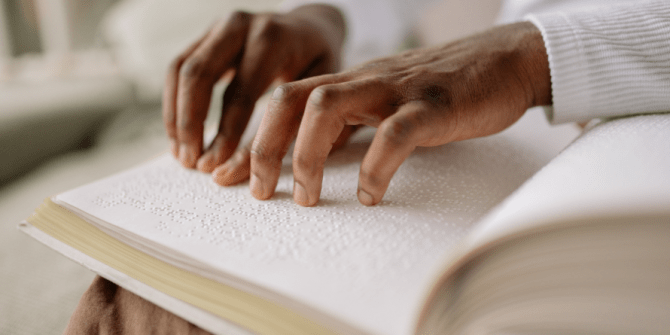
By Shelley Roossien | Accessibility & Inclusion Specialist
The KDL Talking Book and Braille Center (TBBC) is celebrating its 50th anniversary in 2023! I have been a part of the program since I started with KDL in 2004, and I can’t help but think about all the changes and history of our service as we approach this milestone year.
In 1973, what was then the Kent County Library System signed a contract with the Library of Michigan to join the Consortium of User Libraries, a group of libraries across several states that would provide audio andBraille materials to patrons that could not read standard print due to a visual or physical disability. This was part of a nationwide program funded through the Library of Congress’s National Library Service for the Blind, which began in 1931. The program, known as the Library for the Blind & Physically Handicapped (LBPH), quickly became a lifeline to reading for people with print disabilities across the service area of Kent, Ionia and Montcalm Counties.
In the 1970s, hard copy Braille and audiobooks on records were provided free of charge through the mail to patrons eligible for the service from the main KCLS building on Ball St. By the end of the decade, audiobooks transitioned from records to cassette tapes, a format that persisted for the next 30 years. When KCLS transitioned to Kent District Library, the LBPH program moved to the Grandville Branch. Each morning, staff would pull the corresponding materials from the collection and mail them out, while afternoons were spent checking in returned items, which included rewinding cassettes on a special rewinder.
As the LBPH collection grew, the decision was made to move the operation from the Grandville Branch to the new Wyoming Branch building when it opened in 2002. This provided more space for the books and specialized playback machines needed for the program. However, the Grandville Branch continued to house a small group of volunteers that would repair LBPH equipment in the basement of the
building. Gerry Garvelink, who still repairs machines for the program today, joined the group in the spring of 2003. “We would gather on Mondays and re-condition the tape playing machines. They were often a challenge to restore to good operating condition. We would then mail the re-conditioned machines back to Lansing,” Gerry recalls.
I took over as the Library for the Blind & Physically Handicapped Specialist in the summer of 2007. I was eager to start learning this niche section of the KDL system and provide outreach to patrons and organizations in the area to spread awareness of the program.
By this time, the bulk of our audiobook users received materials on cassette. In 2010, the National Library Service in Washington, D.C. launched the newest format: digital cartridges. This was a much more efficient method of production and came with an entirely new machine for patrons, one that was less expensive to manufacture and easier to operate and repair. Gerry says, “These machines were a huge step forward in the area of talking book players. I, personally, have re-conditioned thousands of these [digital players] over the years, and at least 99% of them required only a fully charged battery to bring them back to full performance. They are a pleasure to work with, especially after our experiences with the tape-playing version.” A few years later, circulation of books was centralized at the Library of Michigan’s Braille & Talking Book Library, eliminating theneed for a physical collection at the Wyoming Branch.
On the outreach front, I started a Braille Awareness program in 2014 targeted at sighted school-age
children to help educate them about blindness and Braille literacy. The program was highly successful, and I spoke to over 800 students over the course of a few months. This program, along with continued efforts to increase our LBPH user base and circulation, led to KDL receiving the National Library Service Library of the Year Award in 2015. This is a high honor, and to this day, I am extremely proud of the work we have done to achieve it.
In 2019, KDL changed the name of the program from the Library for the Blind & Physically Handicapped to the Talking Book & Braille Center. With a rebranding in place, the system moved to a new service model by providing customized, multi-title digital cartridges to patrons, and the staff at KDL’s Patron Services Department took over handling TBBC patrons' needs in February of 2020. Because of this new service model, our patrons were able to continue to receive audiobooks and Braille materials through the mail throughout the entirety of the COVID shutdown. And now on the horizon, we are set to launch new services in the coming years, like smart speaker technology and digital Braille eReaders, allowing more people than ever to participate in the program.
Over the years, I have received countless notes and calls from our TBBC users, expressing how thankful they are that KDL provides materials to those that experience print disabilities. My role at KDL has changed a bit, as I am now the Accessibility & Inclusion Specialist, which includes services for people with all types of disabilities throughout the organization, but I still maintain oversight of the Talking Book & Braille Center. It has truly been a rewarding experience and I can’t wait to see how the program continues to evolve at KDL. Congratulations KDL and TBBC!


Add a comment to: Talking Book & Braille Center Celebrates 50 Years at KDL